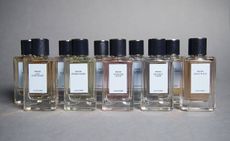Leading perfumers create fragrances inspired by the Louvre’s great works of art
Officine Universelle Buly plumbed the museum's historical collection, inspiring eight new fragrances that make for picture-perfect keepsakes

Last year 10.2 million visitors crossed the threshold of the Louvre. It’s the largest, most replete museum of art in the world and has no trouble drawing a crowd. But we know that. The crowd is the precise reason why perhaps 10 million more didn’t darken its doors. Of the 30-40 000 art-lovers who visit a day, however, 70-80 per cent queued to see the Mona Lisa while other galleries stood empty. Adel Ziane, the Louvre’s Director of External Relations and his team are on a mission to change perceptions, and find ways to breathe new life into the less favoured wings and disseminate knowledge of art history by engaging all the senses. ‘The idea is not to bring more people in, but to welcome them in a different way,’ says Ziane, who is also keen to emphasise that perceived access difficulties are eased somewhat through internet sales, late openings and free/reduced access at down times. ‘The Louvre is not just a museum, it was a fortress in the 12th-century, then a palace, now a museum. Some of the galleries have specific smells, for example. We can connect all our senses to the spirit of the space, not just our vision.’
This thinking led to an approach to the masters of invention in the olfactory world, Ramdane Touhami and his wife Victorie de Taillac Touhami of Officine Universelle Buly. There was a space up for grabs in the basement retail area, the Carrousel du Louvre, and word went out to the Touhamis, with the challenge to help find new ways to connect the public to the galleries. And that was just about it. Ramdane, the industry maverick who has made an art of plumbing historical archives to rejig, reinvent, and give narratives to old products and branding, bringing heritage brands to a modern audience, was left to work his art-olfactory alchemy.

La Venus de Milo, scented postcard
The idea he and Victoire came up with was to create the ultimate take home souvenir – a perfume inspired by one of the Louvre’s great works of art. To this end, they selected eight leading perfumers from various fragrance houses (Givaudan, IFF, Robertet and Symrise) and took them on a tour of the hallowed halls when the museum was closed, inviting them to pick a work of art to illustrate through scent. The perfumers had carte blanche, which interestingly, despite there being around 35 000 artworks on show, brought two paintings by one artist to the table (Ingres), and three marble sculptures. All of the eight chosen works feature people (there’s not a single still life among them) and seven of the eight feature women. The resultant scents (see below for individual details) have been developed as Buly’s Eau Triple (an alcohol-free perfume, 150 euros), and also candles in terrazzo containers (150 euros), scented soap sheets (3 euros). In a clever melding of the fragrance concept with traditional museum shop memorabilia, scented postcards and posters are also available.
The project wasn’t without hurdles: near impenetrable rulings governing the reproduction of artworks meant that the bottles are the classic, vintage-tinged, unadorned Buly bottles and the scented postcards are Buly’s in-house illustrations of the works. ‘We ended up buying up all the old postcards we could find of the art works,’ says Ramdane, ‘and then had them illustrated, which was allowed.’ Even the sampling of the perfumes in the Louvre space presented a challenge – no spraying is allowed. Not the sort to let such an obstacle get in his way, Ramdane took the challenge to Japan, a second home to him and his family, where he had glass atomised diffusers that would circumnavigate the spray issue, specially made. They can be seen alongside the whole collection in their Carrousel shop, an inviting space that aesthetically blends Buly’s characteristic 19th century pharmacy feel with the trappings of an old museum gallery.
The concept was a winner for Ziane and his team. ‘The Louvre is a house of living artists,’ he explains, adding that the perfumers were simply joining a roster of living artists who have been invited over the years to do residencies and be inspired by the Louvre’s collections. To enjoy the fruits of this particular residency, tickets should be booked speedily. Masters of building buzz in the beauty world, the Touhami's plan to cease production of the products after a year. If you miss out….well, the masterpieces are still there, and rest assured that the Touhamis are now in conversation with NASA, so the next project on the way from Buly could be literally out of this world.
The perfumes and the paintings that inspired them...

Ingre’s Grande Odalisque, chosen by IFF’s Domitille Michalon-Bertier, is the epitome of sensuality. The Odalisque is the imagined concubine of a sultan, all serenity and silky skin, albeit anatomically fantastical too (the painter has endowed her with a few extra vertebrae, a gravity defying breast and impossibly positioned leg). Something of a gift to a perfumer looking for feminine inspiration, Michalon-Bertier represents the pale, powdery skin with almond oil and heliptrope, orris and musk while the oriental situation inspired the addition of pink pepper, incense and cardamom.

The second Ingres masterpiece, The Valpinçon Bather (above), was picked by Miuccia Prada’s favourite perfumer, Daniela Andrier (Givaudin). The painting, another groundbreaker painted when Ingres was residing at the French Academy in Rome, shows a nude that is given little context, nor anatomical accuracy. The mystery bather has inspired a fresh burst of citronella and orange blossom, enriched with patchouli and incense.

Fragonard’s The Lock (above) is interpreted by Delphine Lebeau of IFF. For Lebeau, the ambiguous painting which dates from a libertine period in the 18th-century, represents the ‘timeless topic of love and desire. It is soft and gentle, sensual and captivating.' Bright lily represents the yellow dress and apple notes are used to modernise the lily, while a chestnut accord represents the dark red curtain alongside musk.

Dorothée Piot of Robertet chose Conversation in a Park (above), by Gainsborough. Believed to represent the artist and his wife elegantly engaging in the art of conversation, the painting is a typical representation of British high society in the 18th-century. ‘I loved the tenderness of the characters. I saw a beautiful taffeta dress that evokes fresh rose petals, the beautiful face, slightly made up, suggesting a hint of musk. Behind the couple is beautiful vegetation, inspiring a fresh note.' Ottoman rose and musk mix with a vegetal accord of bergamot and fresh peppermint, moss and vanilla.

Perhaps the most fascinating painting choice is Georges de La Tour’s Saint Joseph the Carpenter (above), a painting showing St Joseph and Jesus as a young boy. Pregnant with emotion, it has been suggested that the painting shows the carpenter crafting his son’s future cross. There’s tenderness, passion, sacrifice and forboding condensed into the image. ‘I wanted that when you smell you can feel the painting,' says the perfumer Sidonie Lancesseur of Robertet. ‘I liked the contrast of light, the worried look of the carpenter, the innocent look of the child.' The perfume has a woody accord full of contrast to represent the chiaroscuro. There’s amber, vetiver and cedar, with pink pepper and incense, a heart of bergamot for freshness, and for the innocence, orange blossom and bitter almond.
Wallpaper* Newsletter
Receive our daily digest of inspiration, escapism and design stories from around the world direct to your inbox.

Pictured above, The Venus de Milo, dating from around 100BC, is the incomplete marble figure discovered in 1820 on Milos Island, Greece. It is one of the most celebrated pieces of Greek sculpture. ‘For me the Venus de Milo is a very characterful, feminine sculpture. Something about her feels alive,' says perfumer Jean-Christophe Hérault (IFF). He interpreted this with jasmine sambac absolute, tuberose absolute and gardenia balanced with mandarin. ‘The expression is very neutral, cold and stoney. I used a woody, ambery accord to bring something cold to the perfume.'

Though also missing body parts (the head and arms) The Winged Victory of Samothrace, (above) a once painted marble figure, standing at the bow of her boat, swathed in wet robes, has an energy that drew the eye of perfumer Aliénor Massenet (Symrise). ‘The emotions are intense. For me it is extremely feminine – representing the victory of a woman.' She illustrated this with a bouquet of Mediterranean flowers – rose, jasmine and magnolia – mixed with an airy ozonic note and myrrh to bring a mineral stone aspect.

Nymph with the Scorpion (above) by Lorenzo Bartolini is a 19th-century sculpture in milky marble of a young woman just bitten by a scorpion, suggested by her hand reaching to the bite on her foot, and her slightly open mouth. Annick Ménardo has interpreted her milky skin with heloptrope and jasmine, and spiced it up with amber and musk.
INFORMATION
-
 The new Ford Capri wants to tap a vein of Gen X nostalgia. Does it succeed?
The new Ford Capri wants to tap a vein of Gen X nostalgia. Does it succeed?We ask if the all-electric Ford Capri can capture the swagger of its much-loved but rather oafish predecessor
By Guy Bird Published
-
 Rug designer Sibylle de Tavernost’s homage to Fernand Léger
Rug designer Sibylle de Tavernost’s homage to Fernand LégerAbstract modern art, craft heritage and contemporary life fuse in Sibylle de Tavernost's new limited-edition rugs
By Harriet Thorpe Published
-
 Private gallery Stiftung Froehlich in Stuttgart stands out with an organic, cloud-shaped top
Private gallery Stiftung Froehlich in Stuttgart stands out with an organic, cloud-shaped topBlue-sky thinking elevates Stiftung Froehlich, a purpose-built gallery for the Froehlich Foundation’s art collection near Stuttgart by Gabriele Glöckler
By Hili Perlson Published
-
 Making scents: Prada bucks convention with a collection of surreal fragrances
Making scents: Prada bucks convention with a collection of surreal fragrancesBy Pei-Ru Keh Last updated
-
 Architects Diller Scofidio + Renfro design the ’Art of Scent’ show at MAD, NY
Architects Diller Scofidio + Renfro design the ’Art of Scent’ show at MAD, NYBy Sam Eichblatt Last updated